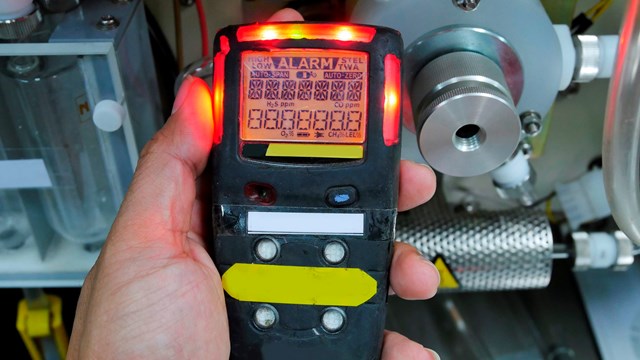
This winter, like all before it, is sure to see thousands of New Yorkers suffering from colds, sore throats, and run-of-the-mill-but-always-inconvenient flu. While fatigue, headaches, and even nausea are miserable in and of themselves, with cold weather there also comes a greater chance that those unpleasant-but-bearable symptoms might be a sign of something much more serious—carbon monoxide poisoning.
According to the New York City Fire Department, approximately 500 Americans die every year from accidental carbon monoxide poisoning and approximately 5,000 are treated for exposure at area hospitals. Often called a “silent killer,” carbon monoxide fumes are undetectable by human senses—they are colorless, odorless, and tasteless. Carbon monoxide (CO) is a naturally occurring gas, and CO fumes are present everywhere at harmless levels—but when the levels get too high in an enclosed space, carbon monoxide can be deadly.
You Are Not Safe
Last November, after a number of well-publicized cases of CO poisoning, Local Law 7 was passed, mandating that residential buildings in New York City install CO detectors in every dwelling unit. Despite the new law, many apartment owners are still of the impression that they are less at-risk than single-family homeowners because their apartments are less likely to include many of the typical leading causes of excess carbon monoxide, such as fireplaces, water heaters, or other fuel-burning amenities. This is far from the case. Carbon monoxide detectors are a necessary part of every household. John Drengenberg is the consumer affairs manager for Underwriters Laboratories (UL) in Northbrook, Illinois. Prior to the passage of Local Law 7, UL partnered with New York City to set standards for carbon monoxide detectors.
“I’ve had people ask me why they even needed one, since they live in an apartment with electric heat” says Drengenberg, “and yet right here in our area we had two people die over the weekend because somebody left their car running in the underground garage in the apartment building.”
According to Jennifer Givner, a spokesperson for the New York City Department of Buildings (DOB), the city’s population density and the uniqueness of New Yorkers’ living situations because of crowding are two good reasons to be more—not less—aware and cautious of the threat of carbon monoxide.
Drengenberg agrees, and points out that within even a small building, people’s habits, lifestyles, and priorities can differ vastly. “You could be a very concerned person, doing a very good job of CO-proofing your apartment and making sure everything’s okay,” he says, “but the guy across the hall could be a real slob.”
The CO Culprits
Although most people are exposed to carbon monoxide outdoors, the majority of carbon monoxide poisoning incidents occur in enclosed settings. Many household items produce carbon monoxide fumes at normal levels, but these same items, if left damaged or improperly installed, can raise carbon monoxide levels and lead to a hazardous, or even deadly, situation.
These potentially hazardous conditions include leaking or clogged chimney pipes or flues, cracked heat exchangers, gas or wood-burning fireplaces, and certain non-electric appliances, like corroded or disconnected water heater vent pipes, unvented clothes dryers, improperly installed kitchen ranges or cook-top vents, and portable space heaters. Other potential sources of carbon monoxide poisoning include snow-blocked exhaust pipes in running cars or trucks, automobiles running in a closed garage, or operating a barbecue grill indoors.
New Yorkers may also be exposed to a higher level of carbon monoxide than residents living in other areas of the U.S since exhaust from cars and trucks produces carbon monoxide—if you’ve ever lived in a ground-floor apartment on a busy street, you know how thick the fumes can get during rush hour.
According to www.carbonmonoxidekills.com, an informational website devoted to hazards posed by CO, percentages of carbon monoxide are higher in cities with significant automotive pollution. The percentages of carbon monoxide can increase during heavy pollution, such as during a traffic jam. New Yorkers may be more at risk. The American Lung Association’s State of the Air: 2005 report ranked New York County as the 15th worst for air particle pollution in the country.
Regardless of where you live, the risk of CO poisoning from overexposure is greatest during the winter months due to the increased use of heating equipment. The symptoms of carbon monoxide poisoning start with flu-like symptoms such as headaches, dizziness, weakness, sleepiness, redness of the skin, confusion, and nausea, and can lead to loss of muscle control, shortness of breath, chest tightness, visual changes, fluttering of the heart, slowed reaction time, loss of consciousness, and eventual death. The New York State Department of Health advises that carbon monoxide poisoning should be suspected if more than one member of the family is sick and if they feel better after being away from home for a period of time.
Protect Yourself
There are a variety of ways to minimize the danger of carbon monoxide poisoning. The FDNY lists the following precautions on their website (www.nyc.gov/html/fdny):
Never heat your home with a gas stove /gas range
• Never use a charcoal grill or a hibachi in your home
• Never use a gas-powered generator or machine in your home or basement
• Make sure all fuel-burning appliances are properly installed and maintained by a certified technician
• Never use a gas powered machine by an open window (fumes can seep into the home)
• Always clear exhaust pipes from automobiles and trucks during snowstorms
• Make sure fireplace, chimneys and flues are checked and cleaned every year
• Never sit in a car or leave it running in a closed garage
• Most importantly, install a carbon monoxide detector in your home
Aside from avoiding the above situations, installing and maintaining a carbon monoxide detector in your home is really the only way to fully protect yourself and your family. According to Drengenberg, there are a few simple steps you should take to ensure that your detector is working at peak performance:
Make sure that your detector is “UL-listed.” Manufacturers of detectors submit samples to Underwriters Laboratories, whose engineers and technicians then run the samples through a battery of tests to ensure that they meet all standards, construction and marking requirements. All aspects of the detectors are tested, including the durability of the plastic enclosure, response to CO, temperature (to make sure detectors will not overheat), and the sound of the alarm (the requirement is 85 decibals).
• Test the alarm once a month. You will hear if it is working.
• Change the alarm’s battery at least once a year.
• Replace the entire detector every seven to 10 years.
• If you move into a new apartment, make sure to replace the alarm. You don’t know how long it has been there or who has been maintaining it.
• Clean dust and cobwebs off the detector. If they get too thick, the detector may not be able to properly detect the presence of CO.
“The nice thing about carbon monoxide alarms is that when they sound, it’s not like a smoke alarm,” Drengenberg says. “When a smoke alarm sounds in the middle of the night, you’d better get up and get everybody out – you don’t know how many seconds or if you even have a minute before something terrible could happen if there is a fire. But [a CO alarm] usually sounds the alarm long before you can even experience the very first symptoms of poisoning.”
There is a potential downside to such an early warning system, however: people sometimes have a tendency to ignore the alarm. If your CO alarm sounds, set the reset button, open a window or get outside to fresh air, and call 911, particularly if people aren’t feeling well. And then, most importantly, find out what set it off. Many people are led into a false sense of security once the alarm sounds and they breathe fresh air. To ensure that the hazard is actually gone, it’s necessary to take certain precautions once your detector sounds, including checking out all possible CO sources and calling in a professional to find the root of the problem.
“It’s easy to ignore a CO alarm because everything looks normal,” Drengenberg says. “You haven’t smelled anything, you haven’t tasted anything, you don’t feel sick and you’ve got many other things to do in your life. Running around checking your flue pipes, your water heater, your fireplace, are not things you had scheduled for your day. Consequently, it’s easy enough to ignore but it’s not a good idea.”
In addition to checking when there is a problem, the New York State Health Department also recommends scheduling annual maintenance on all furnaces and other heat sources to ensure they are properly vented and maintained.
CO and the Law
In co-ops and condos, Local Law 7 holds building or unit owners responsible for the installation and upkeep of CO detectors. The Department of Buildings website (www.nyc.gov/html/dob/ html/guides/co_faq), also cites the relevancy of the individual building’s proprietary lease, bylaws, or condominium declaration in determining responsibility for providing detectors. The city’s Department of Housing Preservation and Development (HPD) states that the co-op/condo board and shareholders are responsible for delegating the overall responsibility of the installation.
Management companies have also been looked to for guidance in following the law, and have responded in various ways. Robert Grant, director of management for Manhattan’s Midboro Management, chose to cover the research and costs of installing CO detectors in all units and public areas of all of their buildings. Midboro is also handling maintenance of the detectors, using spreadsheet checklists to confirm that all tenants have a working CO detector installed, and to carry out monthly detector performance tests. Midboro considers this responsibility as an important service to their tenants. “It’s a matter of saving lives,” says Grant.
Cooper Square Realty’s Dan Wurtzel has also supervised the installation of all detectors in his company’s buildings and keeps the same types of records. Under the guidelines of the law, however, their buildings either absorbed the cost of installation themselves or billed back shareholders the $25 per detector.
Harry Smith, the director of management and vice president of management firm Gumley-Haft, and Jeffrey Friedman, a broker with Vintage Real Estate Services, took similar approaches and both agree that prior to the law, the threat of CO was not foremost in most people’s minds. According to Friedman, the fact that the CO-associated deaths reported shortly before Local Law 7 took effect were all in single-family homes, perhaps further reinforced the myth that CO isn’t a problem in multi-family buildings.
According to Smith, Gumley-Haft chose to install detectors in all of their buildings, including those that do not require them under the law (like those that operate steam generators, for example), because of raised consciousness about CO, and the danger of it occurring inside —or outside—any building.
“As people became more aware, due to the incidents that occurred and inspired Local Law 7, more and more people have become sensitive to the danger of CO,” says Smith. “And now, often the installation of detectors is not due just to the mandate, but to the fact that, with information on CO now front-and-center for people, it just makes sense to them to have detectors installed.”
However your co-op or condo board and shareholders choose to comply with the mandate of Local Law 7, the key to protecting yourself, your family, and your neighbors from carbon monoxide poisoning is knowing about the risk and taking responsibility for reducing it.
“Ultimately, responsibility for not being in compliance with the law is going to lie with an owner,” says Givner. “However, we encourage everyone to put in a carbon monoxide detector. Whether or not a law says you have to, it’s just a safer way to go about living in your home.”
Liz Robbins is Associate Publisher and Kim Cameron is Editorial Assistant for The Cooperator.






6 Comments
Leave a Comment